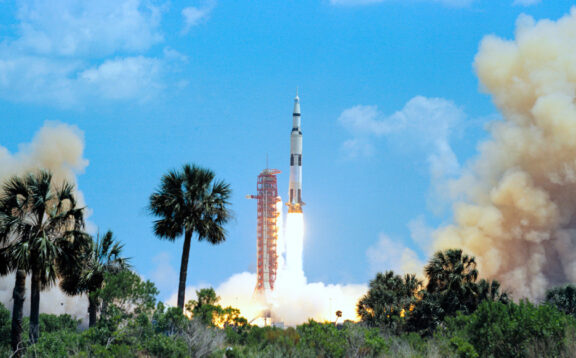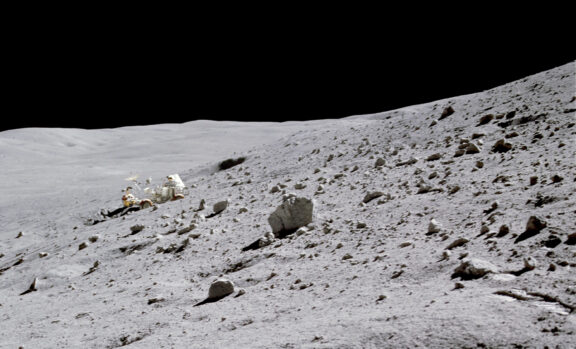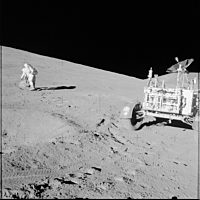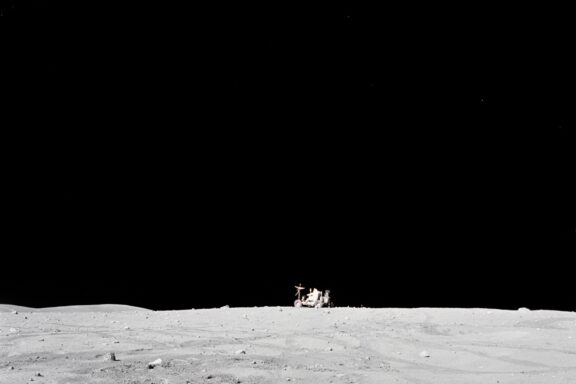In January of 1972, four months before the launch of Apollo 16, President Richard Nixon sat in his cramped California office, on a couch, holding the future of NASA in his hands. It was a model of a reusable space plane — a space shuttle — that promised to dramatically change the way NASA went to space. Next to the President, on the same couch, was James Fletcher, who was less than a year into his tenure as NASA Administrator, looking relieved. Nixon was finally announcing the formal commitment to the next era of human spaceflight. But it would not look like Apollo.
In a statement released later that day, Nixon explained his thinking: "1972 is a year of conclusion for America's current series of manned flights to the Moon…[human spaceflight] can never be more than fractionally realized so long as every single trip from Earth to orbit remains a matter of special effort and staggering expense."

Apollo 16 was thus a reflection of past ambitions by the time it launched on April 16th, 1972. No longer representing the future of the nation’s space program, exploring the Moon was a statement of prior goals and races already won. The coming half-century would be dominated by space closer to home: Earth orbit.
But Apollo 16 would be no half-hearted retread of past glories. Commander John Young, Lunar Module Pilot Charlie Duke and Command Module Pilot Ken Mattingly crewed the second scientifically-rich “J-class” Apollo mission, which included the lunar rover, new instrumentation and upgraded life-support equipment that extended time on the lunar surface.

The destination was the Descartes region in the lunar highlands, with a landing site more than 2,250 meters (7,400 feet) higher in elevation than Apollo 11. The bright soils of the highlands are more representative of the lunar surface geology than the darker mares visited by previous missions, and scientists hoped to find evidence of ancient volcanic activity in the surrounding area.
The Saturn V launched right on schedule at 12:54 pm ET on April 16th, and for the most part, the cruise to the Moon was free of major glitches. The largest technical issue in the mission came after the undocking of the Command and Service Module (CSM) from the Lunar Module (LM), prior to the landing attempt. Shimmying oscillations in the service module’s main engine prevented Ken Mattingly from circularizing his orbit as planned, which forced a hold on landing, since any problems with the main engine might require the use of the LM’s descent engine as backup to return the crew to Earth. After nearly six hours of uncertainty, while Ken Mattingly floated in the command module and John Young and Charlie Duke remained suited up in the lunar module orbiting nearby, NASA engineers decided the issue was manageable, saving the second-to-last lunar landing.
After an uneventful landing, mission control insisted that Young and Duke first get some sleep before attempting any extravehicular activity — they had been up for nearly 24 hours due to the technical problems. They were the first lunar crew to report sleeping soundly in the cramped lunar module, perhaps because of their exhaustion or perhaps due to the unusually level landing spot found by Young.

The two astronauts performed three EVAs over the course of the next 71 hours, spending a record of 20 hours and 14 minutes outside on the Moon. In addition to deploying the Apollo scientific package (ALSEP), they traveled nearly 27 kilometers (17 miles) and collected 96 kilograms (213 pounds) of samples. Young and Duke delighted in the EVAs, whooping and hollering while bouncing across the Moon in the lunar rover and apologizing at times for the overuse of "spectacular" to describe their experience.
The most dramatic stop was "House rock" — a massive chunk of impact breccia discovered while driving near North Ray Crater. Standing at least 20 meters (65 feet) tall, mission control initially misjudged its distance from the astronauts, which took longer than expected to reach and sample. After the crew's safe return to Earth and splashdown on April 27th, 1972, scientists studying the returned samples found that their formation theories of Descartes were incorrect — it was not created by volcanic activity, instead it was the likely result of impact cratering like many other spots on the Moon.
That did not change the experience for commander John Young who remarked upon his return, "I think we’ve seen as much in 10 days as most people would have seen in 10 lifetimes."
Apollo 16 Cost
NASA estimated the following average marginal costs for Apollo 16. Full costs of the Apollo program can be found on the "How Much Did the Apollo Program Cost?" page.
| original $ | inflation adjusted $ | |
|---|---|---|
| Command & Service Module | $65 million | $450 million |
| Lunar Module | $50 million | $345 million |
| Saturn V Launch Vehicle | $185 million | $1.3 billion |
| Science Experiments & Lunar Roving Vehicle | $40 million | $276 million |
| Operations | $105 million | $726 million |
| Total | $445 million | $3.7 billion |
Resources
How much did the Apollo program cost?
A rich data set tracking the costs of Project Apollo, free for public use. Includes unprecedented program-by-program cost breakdowns, facilities construction, salaries, and related programs.
Project Apollo
Starting with Apollo 7 in 1968 and culminating with Apollo 17 in 1972, NASA launched 33 astronauts on 11 Apollo missions. Twelve humans walked on the Moon.


 Explore Worlds
Explore Worlds Find Life
Find Life Defend Earth
Defend Earth




